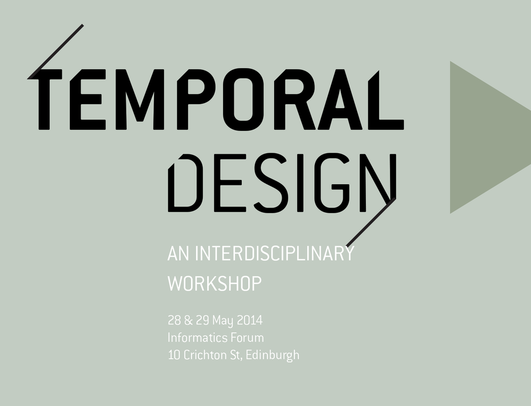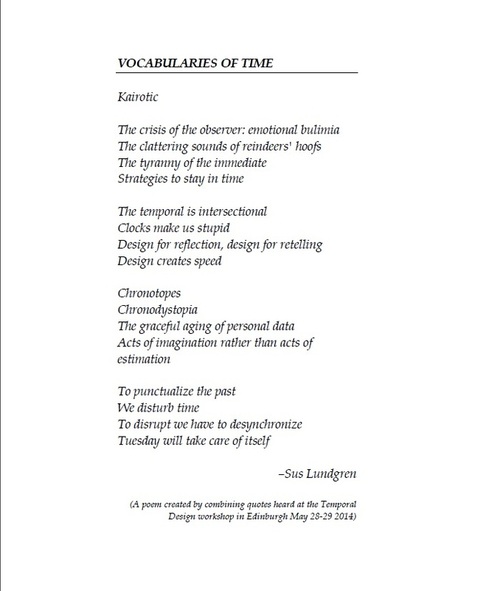Temporal Design: An Interdisciplinary Workshop
28-29th May 2014, Edinburgh College of Art, University of Edinburgh
Organised by: Michelle Bastian, Larissa Pschetz and Chris Speed

Persistent questions around the changing nature of speed, productivity and efficiency have fostered widespread interest in redesigning the time of our lives. Whether supporting slower experiences of time (The Present by Scott Thrift), highlighting the incompatibility between time scales (Artificial Biological Clock by Revital Cohen) or seeking to redefine the time of working life (Time & Motion exhibition curated by Mike Stubbs), the need to redesign time in order to better address current concerns is making itself felt.
This workshop explored how designers, artists, activists and theorists might be contributing to the newly emerging field of Temporal Design. We discussed what might be the scope of the field and initiated What is the scope of this field? What kinds of interdisciplinary conversations are needed? How might designers develop critical responses to the new temporal infrastructures of the network society?
Our aim was to catalyse discussion around the past and futures of Temporal Design and to showcase some of the theories, objects and methods that are contributing to its development. We reflected on what it might mean to ‘design time’ and what opportunities there might be for intervening into dominant rhythms, tempos and flows.
Listen: Presentations and see the outcomes from our design and open space sessions just below.
Look: Photos taken by our wonderful photographer Sha LI are available on Flickr.
Tweet: A storify of the tweets from the workshop here
Verbs: A Temporal Design verb list inspired by Richard Serra
This event was held in conjunction with Design Informatics at the University of Edinburgh.
This workshop explored how designers, artists, activists and theorists might be contributing to the newly emerging field of Temporal Design. We discussed what might be the scope of the field and initiated What is the scope of this field? What kinds of interdisciplinary conversations are needed? How might designers develop critical responses to the new temporal infrastructures of the network society?
Our aim was to catalyse discussion around the past and futures of Temporal Design and to showcase some of the theories, objects and methods that are contributing to its development. We reflected on what it might mean to ‘design time’ and what opportunities there might be for intervening into dominant rhythms, tempos and flows.
Listen: Presentations and see the outcomes from our design and open space sessions just below.
Look: Photos taken by our wonderful photographer Sha LI are available on Flickr.
Tweet: A storify of the tweets from the workshop here
Verbs: A Temporal Design verb list inspired by Richard Serra
This event was held in conjunction with Design Informatics at the University of Edinburgh.
Walkshop
Inspired by a walking workshop designed by Matthew Kearns at UNSW, our workshop began with a walk around Edinburgh's Old Town focusing on the city's historical temporal infrastructure. Designed by Professor Kevin Birth (who planned it all remotely, having never visited the city) we looked at sundials, Japanese pillar clocks, the tradition of meridian and more. Ending up just in front of the Scottish National Gallery so that we could experience the one o'clock gun and the dropping of the time ball on Calton Hill. The walkshop booklet shows the different stops we visited.
Presentations
Click on the links below to listen to the audio
Keynotes:
Lightning Talk Sessions - Insights into Temporal Design:
Keynotes:
- Kevin Birth (CUNY Queens) - As the West Sleeps: Circadian Biology, the Earth as a Rotating Geoid, Colonialism, Postcolonialism, High Frequency Trading, Rush Hour in Asia, the Leap Second, Sleep, Brain Damage and Everything
- Sarah Sharma (UNC Chapel Hill) - In the Meantime: Temporality and Cultural Politics
- Siân Lindley (Microsoft Research) - The Timeline as a Framework for Meaning Making
- Sus Lundgren (University of Gothenburg) - Toying with Time: Considering Temporal Themes in Interactive Artifacts
- Bronac Ferran (Royal College of Art) - Time and Motion
Lightning Talk Sessions - Insights into Temporal Design:
- Anna Barbara (Politecnico di Milano) - Time and Architecture
- Cristian Simonetti (University of Aberdeen) - With the Past Underground
- Chris Elsden (Culture Lab, Newcastle University) - A Quantified Past?
- Fionn Tynan-O'Mahony (University of Edinburgh) - Presentation
- Geoffrey Mann (University of Edinburgh) - The Space Between, Materiality of Time
- Jen Southern (Lancaster University) - Design and Temporal Analysis
- Johan Siebers (Middlesex University) - Of Coaches and couches: The Tao of Temporal Design
- Larissa Pschetz (University of Edinburgh)
- Mark Selby (University of Edinburgh) - Slow Material: Designing Technology for Reflection
- Mike Anusas (University of Strathclyde/University of Aberdeen)
- Peter Bennett (University of Bristol) - Tangible Time
Design Challenge
The aim of this session was to allow groups to reflect on their own methods for managing time in their everyday lives (temporal tactics) and develop a design that might help them address, transgress or make visible, problems that were particularly key for them. We did this through a series of timed (of course) stages that built on each other towards a finished design. Participants then had a chance to leave feedback for each project and also select which ones were their favourite. The winning group was announced in our final session and was awarded prize from Mr Wood's Fossils.
Open Space
After a full morning of listening to a range of approaches to Temporal Design, and creating our own prototypes in the design challenge session, we spent the afternoon in open space sessions discussing, questioning and synthesizing. Participants were invited to propose topics that they would like to explore with others. These might have been prompted by the previous sessions or focus on something that hadn't yet been addressed. The main objective was to not have anyone leave without having had the chance to discuss what was on their minds. Eleven topics were suggested and participants then moved freely between any that were of interest to them.
|
These included:
|
|
Final reflections
|
To wrap up our workshop we heard responses from Craig Martin and Jen Southern before opening up the circle to general discussion.
Craig emphasised the way that design itself is always temporal and always in the process of unfolding. What might this then mean for 'designing time'. He highlighted our interest in measuring time, disrupting time, shifting what counts as time and how we might make time differently. Disciplines and materials also offered multiple ways of understanding, making and living time. Jen took us back to Kevin's walkshop and the way it helped frame the event in terms of the physicality, history, intersectionality and variability of time. She also spoke about the way we became intrigued throughout the workshop with the idea of having agency in relation to time, of being able to disrupt temporal orders. Can we be 'temporal activists', as Sarah Sharma suggested? Can we make interventions in temporal patterns? And particularly the importance of designed objects in enabling us to imagine time differently, something which was illustrated nicely in the pecha kucha session on the morning of Day Two. Each of us then shared what stood out for us from the workshop, what had surprised us. etc. A common theme seemed to be a strong dissatisfaction with the narrowness of the vocabularies, models and objects available for understanding and telling the time. We then drew the discussion to a close with a poem by Sus Lundgren, who picked up on our desire for "acts of imagination rather than acts of estimation." |

